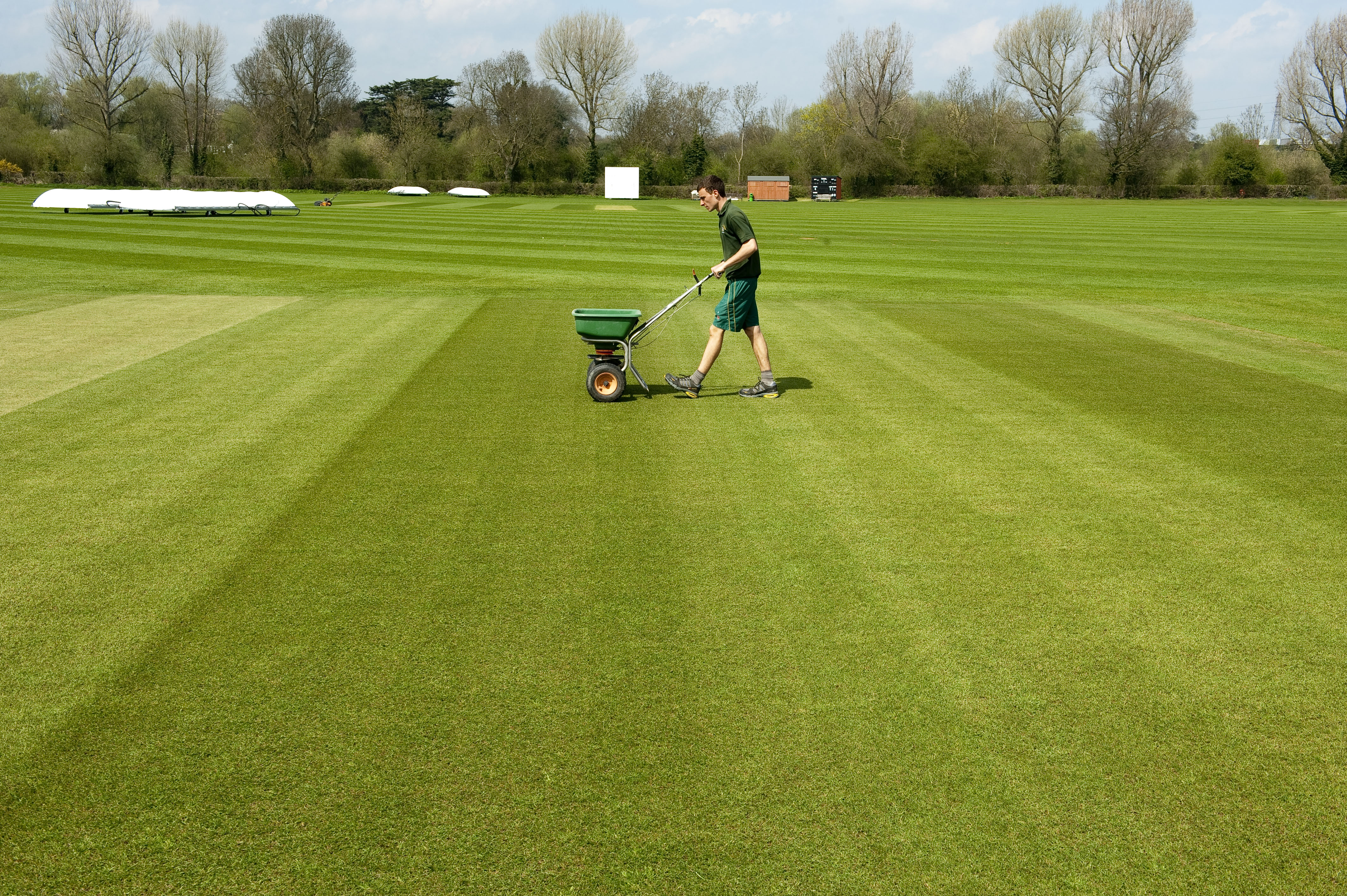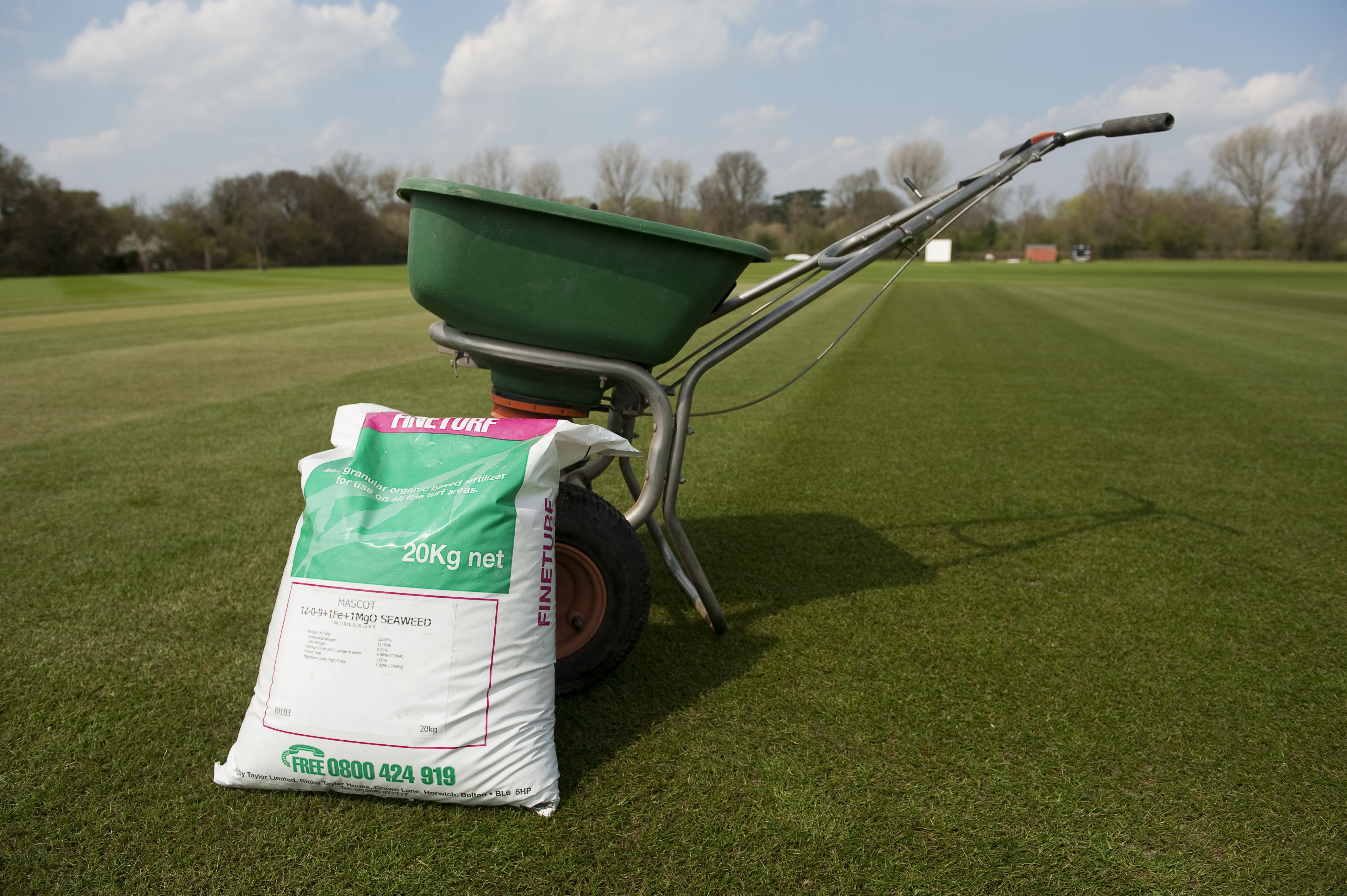Why do we need apply fertiliser to the square?
Fertiliser is needed to replace the nutrients removed in the clippings when the square is cut, loss through leeching from the soil and volatilisation to the air. The grass plant needs the nutrients to grow and develop, to resist and recover from wear and to prevent disease.
Without applying sufficient fertiliser, it will be harder to recover pitches, maintain a good cover of the right grasses (because weeds and weed grasses are better adapted to poor nutrient conditions) and to resist disease.
But be aware that applying too much fertiliser is detrimental to the quality of the sward and pitches, as well as detrimental to the environment (causing air and water pollution and the unnecessary emission of potent greenhouse gasses).
Generally, it is better to slightly under feed than to over feed.
How is fertiliser applied?
There are two principal methods of application:
1. As a solid granule of fertiliser, applied most commonly with a ‘spinning disc’ spreader where the fertiliser falls from the hopper onto a spinning disc that impels the fertiliser through the air. Occasionally alternative methods include using a drop spreader or a ‘waggling spout’ spreader.
This method has the advantage of low equipment cost and easy materials handling (fertiliser tends to be supplied in 20 kg bags). The disadvantage is that the granules must be rained on or watered in to dissolve them into the solution. This is because plants absorb most nutrients in solution through their roots.
Some granular fertilisers have coatings or compounds that are slower to dissolve which allows slow release of nutrients over time.
2. As a liquid applied with a sprayer. As outlined above, plants take up nutrients in liquid form through their roots so using liquid fertilisers means that the plant can be fed quickly, however, liquid fertilisers can also allow foliar feeding, depending on the water rate being used. Some fertilisers can be mixed with other agrochemicals to be applied at the same time. However, it is often not possible to control or slow the release of the nutrient, so using liquid fertiliser can require more frequent applications.
Which fertiliser should I use and how much should I apply?
Different amounts of nutrients are needed at different times so the specific types of fertilisers will vary through the season. You can and should use soil analysis to determine the soil pH (the acidity or alkalinity of a soil, which controls the availability of most nutrients to the plant) and the deficiency or otherwise of certain key nutrients.
Note that soil analyses very rarely include the amount of nitrogen available to the plant. Nitrogen is one of the essential nutrients for grass plants – you will need to apply some nitrogen but applying too much can cause a weak sward because the grass will grow tall and lush but this will be weak growth in excess. All of which means less wear resistance and more mowing.
You should speak to your fertiliser supplier for advice on which fertilisers to apply and in what quantities but in general a March/April application of a ‘Spring/Summer Fertiliser’ with another application in July and then an ‘Autumn fertiliser’ at renovation is a good starting point. Applying autumn/winter fertilisers through the cooler months will assist in maintaining good plant health and may help to prevent the incursion of moss and disease, but too much nitrogen will mean that you have to mow more frequently and risks encouraging disease. It is important not to over apply nitrogen fertilisers in winter as there is a great risk of nitrogen being left unused by the grass which can lead to pollution problems. If in doubt apply at half summer rates but more frequently through the winter especially if the grass is growing.
Beyond this, fine tuning macro and micronutrient levels can benefit the quality of your sward but you should speak to your supplier or advisor.
The amount you will need will depend on the size of your square. Always consult the product label to determine the correct application rate. If in doubt – speak to your supplier.
If you are using granular fertiliser, try to go for ‘fine turf’ or ‘microgranular’ fertilisers because these have smaller granules more suitable for closely mown grass such as your square.
There is likely to be a supplier in your region – you can speak to your County Pitch Advisor who will be able to help identify suppliers in your local area, or you can use the internet – there are online suppliers too.
Caring for the Environment
Fertilisers can cause pollution and release potent greenhouse gasses that cause climate change. Many are also hazardous to health and should be controlled by COSHH. You need to store, handle and use fertilisers carefully and safely.
Always follow the instructions on the product label and for more information look at the supplier’s website and contact your supplier.
Fertilisers applied to cricket squares have low leach potential (wash through the profile into groundwater) because cricket soils are slowly permeable, but they can be washed off the square causing runoff.
Timing Applications and Watering-in
With granular fertilisers these need to be dissolved and washed into the profile so that the plant can access them and also to prevent leaf scorch. The ideal timing for application of granular fertilisers is just before (but not during) moderate rainfall. Light rainfall will protect against leaf scorch but might not be enough to dissolve the fertiliser fully and heavy rainfall could cause runoff and pollution (or at least you will end up putting fertiliser on the outfield rather than the square!). Look at the weather forecast and plan your application.
For most granular fertilisers if it has not rained in the two days after application you should irrigate to water in the fertiliser (follow the product label recommendations).
Be aware that some fertilisers can damage or scorch the plant if they are walked over before dissolving and you do not want to get fertiliser on the ball during play or have players walking and diving on the square so try to time fertiliser application when you have a 3-4 days’ window. Do not apply just before frost or very cold weather is expected – you can waste fertiliser and are at risk of scorching the plant.
Benefits
- Fertilisers help grass growth and recovery from stress.
- Assists with ground presentation and is an important part of a best practice maintenance programme.
Practical Tips
- Avoid over application because this is a waste of money, harms the environment and can weaken your grass.
- Do not apply when frost or very cold weather is anticipated.
- Try to time your application just before (but not during!) rainfall to limit the need for irrigation.
- Always wash down and dry your equipment afterwards because fertilisers can be corrosive to metals in particular, but you should wash down carefully so as not to pollute water courses, sewers, or groundwater. Fertilisers should not be washed down the drain.



 Tweet
Tweet